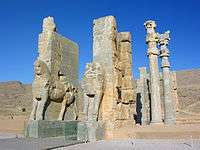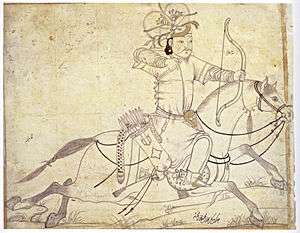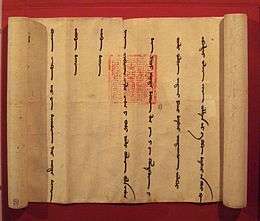Ilkhanate
| Ilkhanate | |||||
| ایلخانان | |||||
| Nomadic empire Division of the Mongol Empire | |||||
| |||||
Ilkhanate at its greatest extent | |||||
| Capital | Maragha (1256–1265) Tabriz (1265–1306) Soltaniyeh (1306–1335) | ||||
| Languages | Persian[1] Mongolian[1] | ||||
| Religion | Shamanism and Buddhism (1256–1295) Islam (1295–1335) | ||||
| Government | Monarchy | ||||
| Khan | |||||
| • | 1256–1265 | Hulagu Khan | |||
| • | 1316–1335 | Abu Sa'id | |||
| Legislature | Kurultai | ||||
| History | |||||
| • | Established | 1256 | |||
| • | Disestablished | 1335/1353 | |||
| Area | |||||
| • | 1310 est.[2] | 3,750,000 km² (1,447,883 sq mi) | |||
| Today part of | | ||||
| History of the Mongols |
|---|
|
Timeline · History · Rulers · Nobility Culture · Language · Proto-Mongols |
|
|
|
Part of a series on the |
||||||||||||||||||||||||||||||||||||||||||||||||||||||||||||||||||||||||||||||||||
|---|---|---|---|---|---|---|---|---|---|---|---|---|---|---|---|---|---|---|---|---|---|---|---|---|---|---|---|---|---|---|---|---|---|---|---|---|---|---|---|---|---|---|---|---|---|---|---|---|---|---|---|---|---|---|---|---|---|---|---|---|---|---|---|---|---|---|---|---|---|---|---|---|---|---|---|---|---|---|---|---|---|---|
| History of Iran | ||||||||||||||||||||||||||||||||||||||||||||||||||||||||||||||||||||||||||||||||||
 | ||||||||||||||||||||||||||||||||||||||||||||||||||||||||||||||||||||||||||||||||||
|
||||||||||||||||||||||||||||||||||||||||||||||||||||||||||||||||||||||||||||||||||
|
||||||||||||||||||||||||||||||||||||||||||||||||||||||||||||||||||||||||||||||||||
|
||||||||||||||||||||||||||||||||||||||||||||||||||||||||||||||||||||||||||||||||||
|
||||||||||||||||||||||||||||||||||||||||||||||||||||||||||||||||||||||||||||||||||
|
||||||||||||||||||||||||||||||||||||||||||||||||||||||||||||||||||||||||||||||||||
|
Related articles |
||||||||||||||||||||||||||||||||||||||||||||||||||||||||||||||||||||||||||||||||||
|
| ||||||||||||||||||||||||||||||||||||||||||||||||||||||||||||||||||||||||||||||||||
The Ilkhanate, also spelled Il-khanate (Persian: ایلخانان, Ilkhānān; Mongolian: Хүлэгийн улс, Hulagu-yn Ulus), was established as a khanate that formed the southwestern sector of the Mongol Empire, ruled by the Mongol House of Hulagu. It was founded in the 13th century and was based primarily in Iran as well as neighboring territories, such as present-day Azerbaijan and the central and eastern parts of present-day Turkey. The Ilkhanate was originally based on the campaigns of Genghis Khan in the Khwarazmian Empire in 1219–24 and was founded by Hulagu Khan, a grandson of Genghis Khan. With the fragmentation of the Mongol Empire after 1259 it became a functionally separate khanate. At its greatest extent, the state expanded into territories that today comprise most of Iran, Iraq, Armenia, Azerbaijan, Georgia, Turkmenistan, Turkey, western Afghanistan, and southwestern Pakistan. Later Ilkhanate rulers, beginning with Ghazan in 1295, would convert to Islam.
Definition
According to the historian Rashid-al-Din Hamadani, Kublai Khan granted Hulagu (Hülegü) the title of Ilkhan after his defeat of Ariq Böke. The term il-Khan means "subordinate khan" and refers to their initial deference to Möngke Khan and his successor Great Khans of the Mongol empire. The title "Ilkhan", borne by the descendants of Hulagu and later other Borjigin princes in Persia, does not materialize in the sources until after 1260.[3]
Early Mongol rule in Persia
When Muhammad II of Khwarezm executed a contingent of merchants dispatched by the Mongols, Genghis Khan declared war on the Khwārazm-Shāh dynasty in 1219. The Mongols overran the empire, occupying the major cities and population centers between 1219 and 1221. Persian Iraq was ravaged by the Mongol detachment under Jebe and Subedei, who left the area in ruin. Transoxiana also came under Mongol control after the invasion. The undivided area west of the Transoxiana was the inheritance of Genghis Khan's Borjigin family.[4] Thus, the families of the latter's four sons appointed their officials under the Great Khan's governors, Chin-Temür, Nussal, and Korguz, in that region.
Muhammad's son Jalal ad-Din Mingburnu returned to Iran in c. 1224 after his exile in India. The rival Turkic states, which were all that remained of his father's empire, quickly declared their allegiance to Jalal. He repulsed the first Mongol attempt to take Central Persia. However, Jalal ad-Din was overwhelmed and crushed by Chormaqan's army sent by the Great Khan Ögedei in 1231. During the Mongol expedition, Azerbaijan and the southern Persian dynasties in Fars and Kerman voluntarily submitted to the Mongols and agreed to pay tribute.[5] To the west, Hamadan and the rest of Persia was secured by Chormaqan. The Mongols invaded Armenia and Georgia in 1234 or 1236, completing the conquest of the Kingdom of Georgia in 1238. They began to attack the western parts of Greater Armenia, which was under the Seljuks, the following year.
In 1236 Ögedei was commanded to raise up Khorassan and proceeded to populate Herat. The Mongol military governors mostly made camp in the Mughan plain in what is now Azerbaijan. Realizing the danger posed by the Mongols, the rulers of Mosul and Cilician Armenia submitted to the Great Khan. Chormaqan divided the Transcaucasia region into three districts based on the Mongol military hierarchy.[6] In Georgia, the population was temporarily divided into eight tumens.[7] By 1237 the Mongol Empire had subjugated most of Persia (including modern-day Azerbaijan), Armenia, Georgia (excluding Abbasid Iraq and Ismaili strongholds), as well as all of Afghanistan and Kashmir.[8] After the battle of Köse Dağ in 1243, the Mongols under Baiju occupied Anatolia, while the Seljuk Sultanate of Rûm and the Empire of Trebizond became vassals of the Mongols.[9] Güyük Khan abolished decrees issued by the Mongol princes that had ordered the raising of revenue from districts in Persia as well as offering tax exemptions to others in c. 1244.[10]
In accordance with a complaint by the governor Arghun the Elder (Arghun agha), Möngke Khan prohibited ortog-merchants and nobles from abusing relay stations and civilians in 1251.[11] He ordered a new census and decreed that each man in the Mongol ruled-Middle East must pay in proportion to his property. Persia was divided between four districts under Arghun. Möngke Khan granted the Kartids authority over Herat, Jam, Pushang (Fushanj), Ghor, Khaysar, Firuz-Kuh, Gharjistan, Farah, Sistan, Kabul, Tirah, and Afghanistan.[12]
First Ilkhan
The founder of the Ilkhanate dynasty was Hulagu Khan, grandson of Genghis Khan and brother of both Möngke Khan and Kublai Khan. Möngke dispatched Hulagu to establish a firm Toluid control over the Middle East and ordered him return to Mongolia when his task was accomplished.[13] Taking over from Baiju in 1255 or 1256, Hulagu had been charged with subduing the Muslim kingdoms to the west "as far as the borders of Egypt." This occupation led the Turkmens to move west into Anatolia to escape from the Mongolian tribes. He established his dynasty over the southwestern part of the Mongol Empire that stretched from Transoxiana to Syria. He destroyed the Ismaili Nizari Hashshashins and the Abbasid Caliphate in 1256 and 1258 respectively. After that he advanced as far as Gaza, briefly conquering Ayyubid Syria.

The death of Möngke forced Hulagu to return from the Persian heartland for the preparation of Khurultai (the selection of a new leader). He left a small force behind to continue the Mongol advance, but it was halted in Palestine in 1260 by a major defeat at the battle of Ain Jalut at the hands of the Mamluks of Egypt. Due to geo-political and religious issues and deaths of three Jochid princes in Hulagu's service, Berke declared open war on Hulagu in 1262 and possibly called his troops back to Iran. According to Mamluk historians, Hulagu might have massacred Berke's troops and refused to share his war booty with Berke.
Hulagu's descendants ruled Persia for the next eighty years, tolerating multiple religions, including Shamanism, Buddhism, and Christianity, and ultimately adopting Islam as a state religion in 1295. However, despite this conversion, the Ilkhans remained opposed to the Mamluks, who had defeated both Mongol invaders and Crusaders. The Ilkhans launched several invasions of Syria, but were never able to gain and keep significant ground against the Mamluks, eventually being forced to give up their plans to conquer Syria, along with their stranglehold over their vassals the Sultanate of Rum and the Armenian kingdom in Cilicia. This was in large part due to civil war in the Mongol Empire and the hostility of the khanates to the north and east. The Chagatai Khanate in Moghulistan and the Golden Horde threatened the Ilkhanate in the Caucasus and Transoxiana, preventing expansion westward. Even under Hulagu's reign, the Ilkhanate was engaged in open warfare in the Caucasus with the Mongols in the Russian steppes. On the other hand, the China-based Yuan Dynasty was an ally of the Ikhanate and also held nominal suzerainty over the latter for many decades.[14][15]
Hulagu took with him many Chinese scholars and astronomers, and the famous Persian astronomer Nasir al-Din al-Tusi learned about the mode of the Chinese calculating tables from them.[16] The observatory was built on a hill of Maragheh.
Franco-Mongol alliance
The courts of Western Europe made many attempts to form an alliance with the Mongols, primarily with the Ilkhanate, in the 13th and 14th centuries, starting from around the time of the Seventh Crusade (West Europeans were collectively called Franks by Muslims and Asians in the era of the Crusades). United in their opposition to the Muslims (primarily the Mamluks), the Ilkhanate and the Europeans were nevertheless unable to satisfactorily combine their forces against their common enemy.[17]
Conversion to Islam
In the period after Hulagu, the Ilkhans increasingly adopted Tibetan Buddhism. Christian powers were encouraged by what appeared to be an inclination towards Nestorian Christianity by Ilkhanate rulers, but this was probably nothing more than the Mongols' traditional even-handedness towards competing religions.[18] The Ilkhans were thus markedly out of step with the Muslim majority they ruled. Ghazan, shortly before he overthrew Baydu, converted to Islam, and his official favoring of Islam as a state religion coincided with a marked attempt to bring the regime closer to the non-Mongol majority of the regions they ruled. Christian and Jewish subjects lost their equal status with Muslims and again had to pay the poll tax. Buddhists had the starker choice of conversion or expulsion.[19]
In foreign relations, the Ilkhanate's conversion to Islam had little to no effect on its hostility towards other Muslim states, and Ghazan continued to fight the Mamluks for control of Syria. The Battle of Wadi al-Khazandar, the only major victory by the Mongols over the Mamluks, ended the latter's control over Syria, though this lasted only a few months. For the most part, Ghazan's policies continued under his brother Öljeitü despite suggestions that he might begin to favor the Shi'a brand of Islam after he came under the influence of Shi'a theologians Al-Hilli and Maitham Al Bahrani.[20] Öljeitü succeeded in conquering Gilan on the Caspian coast, and his tomb in Soltaniyeh remains the best known monument of Ilkhanid rule in Persia.
Disintegration
In the 1330s, outbreaks of the Black Death ravaged the Ilkhanate empire. The last il-khan Abu Sa'id and his sons were killed by the plague.[21]
In 1330, the annexation of Abkhazia resulted in the reunification of the Kingdom of Georgia. However, tribute received by the Il-Khans from Georgia sank by about three-quarters between 1336 and 1350 because of wars and famines.[22] Also Anatolian Beyliks were freed from Ilkhanate suzerenaity.
After Abu Sa'id's death in 1335, the Ilkhanate began to disintegrate rapidly and split up into several rival successor states, most prominently the Jalayirids. Hasar's descendant Togha Temür, who was the last of the obscure Ilkhan pretenders, was assassinated by Sarbadars in 1353. Timur later carved a state from the Jalayirids, ostensibly to restore the old khanate. Historian Rashid-al-Din Hamadani wrote a universal history of the khans around 1315 that provides much material about them. In 1357, the Golden Horde conquered the Chobanid-held Tabriz for a year, putting an end to the last hope for the return of the Ilkhanate. After the demise of the Ilkhanate, the Armenian Kingdom of Cilicia lost Mongol protection against the Mamluks and was destroyed by them in 1375.
Legacy

The emergence of the Ilkhanate had an important historical impact in the Middle Eastern region. The establishment of the unified Mongol Empire had significantly eased trade and commerce across Asia. The communications between the Ilkhanate and the Yuan Dynasty headquartered in China encouraged this development.[23][24]
The Ilkhanate also helped to pave the way for the later Persian Safavid dynastic state, and ultimately the modern country of Iran. Hulagu's conquests had also opened Iran to Chinese influence from the east. This, combined with patronage from his successors, would develop Iran's distinctive excellence in architecture. Under the Ilkhans, Iranian historians also moved from writing in Arabic to writing in their native Persian tongue.[25]
The rudiments of double-entry accounting were practiced in the Ilkhanate; merdiban was then adopted by the Ottoman Empire. These developments were independent from the accounting practices used in Europe.[26] This accounting system was adopted primarily as the result of socio-economic necessities created by the agricultural and fiscal reforms of Ghazan Khan in 1295-1304.

 Ilkhanate, Lampas textile, silk and gold; second half of 14th century.
Ilkhanate, Lampas textile, silk and gold; second half of 14th century. 1305 letter of the Ilkhan Mongol Öljaitü (official square red stamp of the Ilkhanate).
1305 letter of the Ilkhan Mongol Öljaitü (official square red stamp of the Ilkhanate).- Seal of Ghazan
Ilkhans
House of Hulagu (1256–1335; Ilkhanate Mongol kings)
- Hulagu Khan (1256–1265)
- Abaqa Khan (1265–1282)
- Ahmad Tegüder (1282–1284)
- Arghun (1284–1291)
- Gaykhatu (1291–1295)
- Baydu (1295)
- Mahmud Ghazan (1295–1304)
- Muhammad Khodabandeh (Oljeitu or Öljaitü) (1304–1316)
- Abu Sa'id Bahadur (1316–1335)
After the Ilkhanate, the regional states established during the disintegration of the Ilkhanate raised their own candidates as claimants.
House of Ariq Böke
- Arpa Ke'ün (1335–1336)
House of Hulagu (1336–1357)
- Musa (1336–1337) (puppet of 'Ali Padshah of Baghdad)
- Muhammad (1336–1338) (Jalayirid puppet)
- Sati Beg (1338–1339) (Chobanid puppet)
- Sulayman (1339–1343) (Chobanid puppet, recognized by the Sarbadars 1341–1343)
- Jahan Temür (1339–1340) (Jalayirid puppet)
- Anushirwan (1343–1356) (Chobanid puppet)
- Ghazan II (1356–1357) (known only from coinage)
House of Hasar
Claimants from eastern Persia (Khurasan):
- Togha Temür (c. 1338–1353) (recognized by the Kartids 1338–1349; by the Jalayirids 1338–1339, 1340–1344; by the Sarbadars 1338–1341, 1344, 1353)
- Luqman (1353–1388) (son of Togha Temür and the protege of Timur)
Family tree (House of Hulagu)
| Ilkhanate family tree | ||||||||||||||||||||||||||||||||||||||||||||||||||||||||||||||||||||||||||||||||||||||||||||||||||||||||||||||||||||||||||||||||||||||||||||||||||||||||||||||||||||||||||||||||||||||||||||||||||||||||||||||||||||||||||||||||||||||||||||||||||||||||||||||||||||||||||||||||||||||||||||||||||||||||||||||||||||||||||||||||||||||||||||||||||||||||||||||||||||||||||||||||||||||||||||||||||||||||||||||||||||||||||||||||||||||||||||||||||||||||||||||||||||||||||||||||||||||||||||||||||||||||||||||||||||||||||||||||||||||||||||||||||||||||||||||||||||||||||||||||||||||||||||||||||||||||||||||||||||||||||||||||||||||||||||||||||||||||||||||||||||||||||||||||||||||||||||||||||||||||||||||||||||||||||||||||||||||||
|---|---|---|---|---|---|---|---|---|---|---|---|---|---|---|---|---|---|---|---|---|---|---|---|---|---|---|---|---|---|---|---|---|---|---|---|---|---|---|---|---|---|---|---|---|---|---|---|---|---|---|---|---|---|---|---|---|---|---|---|---|---|---|---|---|---|---|---|---|---|---|---|---|---|---|---|---|---|---|---|---|---|---|---|---|---|---|---|---|---|---|---|---|---|---|---|---|---|---|---|---|---|---|---|---|---|---|---|---|---|---|---|---|---|---|---|---|---|---|---|---|---|---|---|---|---|---|---|---|---|---|---|---|---|---|---|---|---|---|---|---|---|---|---|---|---|---|---|---|---|---|---|---|---|---|---|---|---|---|---|---|---|---|---|---|---|---|---|---|---|---|---|---|---|---|---|---|---|---|---|---|---|---|---|---|---|---|---|---|---|---|---|---|---|---|---|---|---|---|---|---|---|---|---|---|---|---|---|---|---|---|---|---|---|---|---|---|---|---|---|---|---|---|---|---|---|---|---|---|---|---|---|---|---|---|---|---|---|---|---|---|---|---|---|---|---|---|---|---|---|---|---|---|---|---|---|---|---|---|---|---|---|---|---|---|---|---|---|---|---|---|---|---|---|---|---|---|---|---|---|---|---|---|---|---|---|---|---|---|---|---|---|---|---|---|---|---|---|---|---|---|---|---|---|---|---|---|---|---|---|---|---|---|---|---|---|---|---|---|---|---|---|---|---|---|---|---|---|---|---|---|---|---|---|---|---|---|---|---|---|---|---|---|---|---|---|---|---|---|---|---|---|---|---|---|---|---|---|---|---|---|---|---|---|---|---|---|---|---|---|---|---|---|---|---|---|---|---|---|---|---|---|---|---|---|---|---|---|---|---|---|---|---|---|---|---|---|---|---|---|---|---|---|---|---|---|---|---|---|---|---|---|---|---|---|---|---|---|---|---|---|---|---|---|---|---|---|---|---|---|---|---|---|---|---|---|---|---|---|---|---|---|---|---|---|---|---|---|---|---|---|---|---|---|---|---|---|---|---|---|---|---|---|---|---|---|---|---|---|---|---|---|---|---|---|---|---|---|---|---|---|---|---|---|---|---|---|---|---|---|---|---|---|---|---|---|---|---|---|---|---|---|---|---|---|---|---|---|---|---|---|---|---|---|---|---|---|---|---|---|---|---|---|---|---|---|---|---|---|---|---|---|---|---|---|---|---|---|---|---|---|---|---|---|---|---|---|---|---|---|---|---|---|---|---|---|---|---|---|---|---|---|---|---|---|---|---|---|---|---|---|---|---|---|---|---|---|---|---|---|---|---|---|---|---|---|---|---|---|---|---|---|---|---|---|---|---|---|---|---|---|---|---|---|---|---|---|---|---|---|---|---|---|---|---|---|---|---|---|---|---|---|---|---|---|---|---|---|---|---|---|---|---|---|---|---|---|---|---|---|---|---|---|---|---|---|---|---|---|---|---|---|---|---|---|---|---|---|---|---|---|---|---|---|---|---|---|---|---|---|---|---|---|---|---|---|---|---|---|---|---|---|---|---|---|---|---|---|---|---|---|---|---|---|---|---|---|---|---|---|---|---|---|---|---|---|---|---|---|---|---|---|---|
| ||||||||||||||||||||||||||||||||||||||||||||||||||||||||||||||||||||||||||||||||||||||||||||||||||||||||||||||||||||||||||||||||||||||||||||||||||||||||||||||||||||||||||||||||||||||||||||||||||||||||||||||||||||||||||||||||||||||||||||||||||||||||||||||||||||||||||||||||||||||||||||||||||||||||||||||||||||||||||||||||||||||||||||||||||||||||||||||||||||||||||||||||||||||||||||||||||||||||||||||||||||||||||||||||||||||||||||||||||||||||||||||||||||||||||||||||||||||||||||||||||||||||||||||||||||||||||||||||||||||||||||||||||||||||||||||||||||||||||||||||||||||||||||||||||||||||||||||||||||||||||||||||||||||||||||||||||||||||||||||||||||||||||||||||||||||||||||||||||||||||||||||||||||||||||||||||||||||||
| Notes:
| ||||||||||||||||||||||||||||||||||||||||||||||||||||||||||||||||||||||||||||||||||||||||||||||||||||||||||||||||||||||||||||||||||||||||||||||||||||||||||||||||||||||||||||||||||||||||||||||||||||||||||||||||||||||||||||||||||||||||||||||||||||||||||||||||||||||||||||||||||||||||||||||||||||||||||||||||||||||||||||||||||||||||||||||||||||||||||||||||||||||||||||||||||||||||||||||||||||||||||||||||||||||||||||||||||||||||||||||||||||||||||||||||||||||||||||||||||||||||||||||||||||||||||||||||||||||||||||||||||||||||||||||||||||||||||||||||||||||||||||||||||||||||||||||||||||||||||||||||||||||||||||||||||||||||||||||||||||||||||||||||||||||||||||||||||||||||||||||||||||||||||||||||||||||||||||||||||||||||
Ilkhan as a tribal title in 19th/20th century Iran
The title Ilkhan resurfaced among the Qashqai nomads of Southern Iran in the 19th century. Jan Mohammad Khan started using it from 1818/19 and this was continued by all the following Qashqai leaders. The last Ilkhan was Naser Khan, who in 1954 was pushed into exile after his support of Mossadeq. When he returned during the Islamic Revolution in 1979, he could not regain his previous position and died in 1984 as the last Ilkhan of the Qashqai. [27]
See also
- Division of the Mongol Empire
- List of Mongol states
- List of medieval Mongol tribes and clans
- Full list of Iranian Kingdoms
- Sarbadars, the famous political movement of the Ilkhanid era of Persia.
- Hazaras
References
- Atwood, Christopher P. (2004). The Encyclopedia of Mongolia and the Mongol Empire. Facts on File, Inc. ISBN 0-8160-4671-9.
- C.E. Bosworth, The New Islamic Dynasties, New York, 1996.
- Kadoi, Yuka. (2009) Islamic Chinoiserie: The Art of Mongol Iran, Edinburgh Studies in Islamic Art, Edinburgh. ISBN 9780748635825.
- R. Amitai-Preiss: Mongols and Mamluks: The Mamluk-Ilkhanid War 1260–1281. Cambridge, 1995.
External links
| Wikimedia Commons has media related to Ilkhanate. |
- Ilkhanids Dynasty Mongolian dynasty
- Encyclopedia Iranica. Contains more information on the Ilkhanate.
- Contains a searchable database for Ilkhanid coins
Notes
- 1 2 Rahiminejad, Sadegh: IRAN: Tarikh (2006). Languages of the Persian [Section]
- ↑ Rein Taagepera (September 1997). "Expansion and Contraction Patterns of Large Polities: Context for Russia". International Studies Quarterly 41 (3): 475–504.
- ↑ Peter Jackson The Mongols and the West, p.127
- ↑ Jeremiah Curtin The Mongols: A history, p.184
- ↑ Timothy May Chormaqan, p.47
- ↑ Grigor of Akanc The history of the nation of archers, (tr. R.P.Blake) 303
- ↑ Kalistriat Salia History of the Georgian Nation, p.210
- ↑ Thomas T. Allsen Culture and Conquest in Mongol Eurasia, p.84
- ↑ George Finlay The history of Greece from its conquest by the Crusaders to its conquest by the Ottomans, p.384
- ↑ C. P. Atwood-Encyclopedia of Mongolia and the Mongol Empire, see:Monqe Khan
- ↑ M. Th. Houtsma E.J. Brill's first encyclopaedia of Islam, 1913-1936, Volume 1, p.729
- ↑ Ehsan Yar-Shater Encyclopædia Iranica, p.209
- ↑ P.Jackson Dissolution of the Mongol Empire, pp.222
- ↑ Christopher P. Atwood Ibid
- ↑ Michael Prawdin, Mongol Empire and its legacy, p.302
- ↑ H. H. Howorth History of the Mongols, vol.IV, p.138
- ↑ "Despite numerous envoys and the obvious logic of an alliance against mutual enemies, the papacy and the Crusaders never achieved the often-proposed alliance against Islam". Atwood, Encyclopedia of Mongolia and the Mongol Empire, p. 583, "Western Europe and the Mongol Empire"
- ↑ Medieval Persia 1040–1797, David Morgan p64
- ↑ Medieval Persia 1040–1797, David Morgan p.72
- ↑ Ali Al Oraibi, "Rationalism in the school of Bahrain: a historical perspective", in Shīʻite Heritage: Essays on Classical and Modern Traditions by Lynda Clarke, Global Academic Publishing 2001 p336
- ↑ Continuity and Change in Medieval Persia By Ann K. S. Lambton
- ↑ D. M. Lang, Georgia in the Reign of Giorgi the Brilliant (1314-1346). Bulletin of the School of Oriental and African Studies, University of London, Vol. 17,No. 1 (1955), pp. 74-91
- ↑ Gregory G.Guzman - Were the barbarians a negative or positive factor in ancient and medieval history?, The historian 50 (1988), 568-70
- ↑ Thomas T.Allsen - Culture and conquest in Mongol Eurasia, 211
- ↑ Francis Robinson, The Mughal Emperors and the Islamic Dynasties of India, Iran and Central Asia, Pages 19 and 36
- ↑ Cigdem Solas, ACCOUNTING SYSTEM PRACTICED IN THE NEAR EAST DURING THE PERIOD 1220-1350, based ON THE BOOK RISALE-I FELEKIYYE, The Accounting Historians Journal, Vol. 21, No. 1 (June 1994), pp. 117-135
- ↑ Pierre Oberling, Qashqai tribal confederacy I History, in Encyclopedia Iranica (2003)
